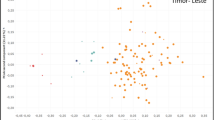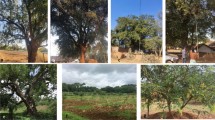Abstract
The genetic characterization of Palestinian safflower landraces remains unknown due to the absence of prior research using molecular methods. Characterizing crop diversity is vital for breeding and germplasm conservation efforts. This study aimed to address this gap by evaluating the genetic diversity of 18 Palestinian local safflower landraces using nine inter simple sequence repeat (ISSR) markers. A total of 123 polymorphic DNA fragments (100%) were identified, with 3–25 fragments per marker and an average resolving power of 7.68. Analysis of the data revealed two major clusters among the genotypes, thereby suggesting distinct genetic diversity within the Palestinian safflower genotypes. Cluster I was further divided into two sub-clusters, whereas Cluster II showed additional branching. In particular, PTUK.SA15 is distinguished as the most genetically distinct. The similarity coefficients ranged from 0.149 to 0.756. The current research represents the first study to utilize molecular markers to analyze the genetic diversity of locally grown Palestinian safflower landraces. The significant polymorphism identified within the ISSR markers confirmed their effectiveness in distinguishing genetic variations among these safflower genotypes.





Similar content being viewed by others
Data availability
All data and materials of the study have been presented in the main manuscript.
References:
Ali F, Nadeem MA, Barut M, Habyarimana E, Chaudhary HJ, Khalil IH (2020) Genetic diversity, population structure and marker-trait association for 100-seed weight in international safflower panel using SilicoDArT marker information. Plants 9(5):652
Amiryousefi A, Hyvönen J, Poczai P (2018) iMEC: online marker efficiency calculator. In: Applications in plant sciences, John Wiley and Sons, New York
Amiteye S (2021) Basic concepts and methodologies of DNA marker systems in plant molecular breeding. Heliyon 7(10):e08093
Basheer-salimia R, Awad M, Salama A, Alseekh S, Harb J, Hamdan Y (2012) Molecular polymorphisms in Palestinian Figs (Ficus carica L.) as revealed by random amplified polymorphic DNA (RAPD). J Genet Eng Biotechnol 10(2):169–175
Basheer-Salimia R, Awad M, Hamdan Y, Shtaya M, Contrary I (2012) Genetic variability of some Palestinian Fig (Ficus Carica L.) genotypes based on pomological and morphological descriptors. An-Najah Univ J Res—A (natural Sci) 27(1):83–110
Basheer-Salimia R, Shtaya M, Awad M, Abdallah J, Hamdam Y (2013) Genetic diversity of Palestine landraces of faba bean (Vicia faba) based on RAPD markers. Genet Mol Res Genet Mol Res 12(3):3314–3323
Chapman MA, Burke JM (2007) DNA sequence diversity and the origin of cultivated safflower (Carthamus tinctorius L.; Asteraceae). BMC Plant Biol 7:60
Earl DA, vonHoldt BM (2012) Structure harvester: a website and program for visualizing structure output and implementing the Evanno method. Conserv Genet Resour 4(2):359–361
Ekin Z (2005) Resurgence of safflower (Carthamus tinctorius L.) utilization: a global view. J Agron 4(2):83–87
Emongor V (2010) Safflower (Carthamus tinctorius L.) the underutilized and neglected crop: a review. Asian J Plant Sci 9(6):299–306
Emongor VE, Emongor RA (2023) Safflower (Carthamus tinctorius L.) neglected underutilized crop. Futur. Smart Food 683–731
Falush D, Stephens M, Pritchard JK (2007) Inference of population structure using multilocus genotype data: dominant markers and null alleles. Mol Ecol Notes 7(4):574
Food and Agriculture Organization of the United Nations (2020) FAOSTAT statistical database. [Rome]. FAO. 2024. Available from: https://www.fao.org/faostat/en/#data/QCL
Golkar P, Mokhtari N (2018) Molecular diversity assessment of a world collection of safflower genotypes by SRAP and SCoT molecular markers. Physiol Mol Biol Plants 24(6):1261
Golkar P, Arzani A, Rezaei AM (2011) Genetic variation in safflower (Carthamus tinctorious L.) for seed quality-related traits and inter-simple sequence repeat (ISSR) markers. Int J Mol Sci 12(4):2664–2677
Hamdan YAS, Pérez-Vich B, Fernández-Martínez JM, Velasco L (2008) Inheritance of very high linoleic acid content and its relationship with nuclear male sterility in safflower. Plant Breed 127(5):507–509. https://doi.org/10.1111/j.1439-0523.2008.01494.x
Hamdan YAS, Hawamda AIM, Basheer-Salimia R, Salman M (2024) Genetic diversity assessment of Palestinian okra landraces (Abelmoschus esculentus L.) through RAPD marker. Genet Resour Crop Evol. https://doi.org/10.1007/s10722-024-01859-x
Hassani SMR, Talebi R, Pourdad SS, Naji AM, Fayaz F (2020) In-depth genome diversity, population structure and linkage disequilibrium analysis of worldwide diverse safflower (Carthamus tinctorius. L) accessions using NGS data generated by DArTseq technology. Mol Biol Rep 47(3):2123–2135
Houmanat K, Charafi J, Mazouz H, El FM, Nabloussi A (2016) Genetic diversity analysis of safflower (Carthamus tinctorius) accessions from different geographic origins using ISSR markers. Int J Agric Biol 18:1081–1087
Khan MA, Von Witzke-Ehbrecht S, Maass BL, Becker HC (2009) Relationships among different geographical groups, agro-morphology, fatty acid composition and RAPD marker diversity in safflower (Carthamus tinctorius). Genet Resour Crop Evol 56(1):19–30. https://doi.org/10.1007/s10722-008-9338-6
Kiran BU, Mukta N, Kadirvel P, Alivelu K, Senthilvel S, Kishore P et al (2017) Genetic diversity of safflower (Carthamus tinctorius L.) germplasm as revealed by SSR markers. Plant Genet Resour 15(1):1–11
Kumar GP, Pathania P, Goyal N, Gupta N, Parimalan R, Radhamani J (2023) Genetic diversity and population structure analysis to construct a core collection from safflower (Carthamus tinctorius L.) germplasm through SSR markers. Agric MDPI 13(4):836
Marwal A, Gaur RK (2020) Molecular markers: tool for genetic analysis. Anim Biotechnol Model Discov Trans. https://doi.org/10.1016/B978-0-12-811710-1.00016-1
Package statistical variate multi-version 3.1 users’ manual kovach computing services (1986)
Nei M (1978) Estimation of average heterozygosity and genetic distance from a small number of individuals. Genetics 89(3):583–590
Panahi B, Ghorbanzadeh NM (2013) Genetic characterization of Iranian safflower (Carthamus tinctorius) using inter simple sequence repeats (ISSR) markers. Physiol Mol Biol Plants 19(2):239
Peakall R, Smouse PE (2012) GenAlEx 6.5: genetic analysis in Excel. Population genetic software for teaching and research—an update. Bioinformatics, vol 28, Oxford University Press, p 2537 Available from: /pmc/articles/PMC3463245/
Powell W, Morgante M, Andre C, Hanafey M, Vogel J, Tingey S et al (1996) The comparison of RFLP, RAPD, AFLP and SSR (microsatellite) markers for germplasm analysis. Mol Breed 2(3):225–238
Prevost A, Wilkinson MJ (1999) A new system of comparing PCR primers applied to ISSR fingerprinting of potato cultivars. Theor Appl Genet 98(1):107–112
Rehman H, Rabbani MA, Khan Shinwari Z, Akbar F (2015) RAPD markers based genetic diversity of safflower (Carthamus tinctorius L.) germplasm. Pak J Bot 47(SI):199–204
Rostami Ahmadvandi H, Jamshid Moghaddam M, Pourdad SS (2022) Assessment of genetic diversity based on agronomic traits in safflower international germplasm under rainfed condition of cold temperate region in Iran. Agrotechniques Ind Crop Razi University 2(2):87–93
Sneath PHA, Sokal RR (1973) Numerical taxonomy: the principles and practice of numerical classification. Available from: https://philpapers.org/rec/SNENTT
Venkatesan J, Ramu V, Sethuraman T, Sivagnanam C, Doss G (2021) Molecular marker for characterization of traditional and hybrid derivatives of (Eleusine coracana L.) using ISSR marker. J Genet Eng Biotechnol 19(1):1–12. https://doi.org/10.1186/s43141-021-00277-1
Vollmann J, Velasco L, Arzani A, Jagannath A, In JC, Goel S et al (2018) Association mapping for important agronomic traits in safflower (Carthamus tinctorius L.) core collection using microsatellite markers. Front Plant Sci 9:402
Yang YX, Wu W, Zheng YL, Chen L, Liu RJ, Huang CY (2007) Genetic diversity and relationships among safflower (Carthamus tinctorius L.) analyzed by inter-simple sequence repeats (ISSRs). Genet Resour Crop Evol 54(5):1043–1051. https://doi.org/10.1007/s10722-006-9192-3
Zangeneh M, Salehi H (2019) Genetic diversity as revealed by intersimple sequence repeat polymorphism in narcissus accessions to identify the tolerant genotypes for deficit irrigation. J Am Soc Hortic Sci 144(2):92–106
Zhao H, Li Y, Petkowski J, Kant S, Hayden MJ, Daetwyler HD (2021) Genomic prediction and genomic heritability of grain yield and its related traits in a safflower genebank collection. Plant Genome 14(1):e20064. https://doi.org/10.1002/tpg2.20064
Acknowledgements
The author extends gratitude to Dr. Ghizlane Diria of the National Institute of Agricultural Research (INRA), Rabat, Morocco, for generously providing the ISSR molecular markers. A special appreciation is expressed to Ala'a Amarneh, Arwad Qabaha, and Shatha Asia for their invaluable technical assistance. The author also acknowledges the support received from Palestine Technical University – Kadoorie.
Funding
Not applicable.
Author information
Authors and Affiliations
Contributions
Yamen A S Hamdan designed, carried out the study, and wrote the manuscript.
Corresponding author
Ethics declarations
Conflict of interest
The author declare that they have no competing interests.
Ethical approval
Not applicable.
Consent for publication
The authors declare that the work has been consented for publication.
Additional information
Publisher's Note
Springer Nature remains neutral with regard to jurisdictional claims in published maps and institutional affiliations.
Rights and permissions
Springer Nature or its licensor (e.g. a society or other partner) holds exclusive rights to this article under a publishing agreement with the author(s) or other rightsholder(s); author self-archiving of the accepted manuscript version of this article is solely governed by the terms of such publishing agreement and applicable law.
About this article
Cite this article
Hamdan, Y.A.S. Genetic diversity analysis of Palestinian safflower (Carthamus tinctorius L.) using inter simple sequence repeat (ISSR) markers. Genet Resour Crop Evol (2024). https://doi.org/10.1007/s10722-024-01962-z
Received:
Accepted:
Published:
DOI: https://doi.org/10.1007/s10722-024-01962-z




